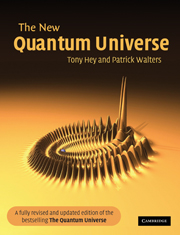Book contents
- Frontmatter
- Contents
- Preface
- Prologue
- Route map
- 1 Waves versus particles
- 2 Heisenberg and uncertainty
- 3 Schrödinger and matter waves
- 4 Atoms and nuclei
- 5 Quantum tunnelling
- 6 Pauli and the elements
- 7 Quantum co-operation and superfluids
- 8 Quantum jumps
- 9 Quantum engineering
- 10 Death of a star
- 11 Feynman rules
- 12 Weak photons and strong glue
- 13 Afterword – quantum physics and science fiction
- Epilogue
- Appendix 1 The size of things
- Appendix 2 Solving the Schrödinger equation
- Glossary
- Quotations and sources
- Suggestions for further reading
- Photo-credits
- Name index
- Subject index
3 - Schrödinger and matter waves
Published online by Cambridge University Press: 05 October 2013
- Frontmatter
- Contents
- Preface
- Prologue
- Route map
- 1 Waves versus particles
- 2 Heisenberg and uncertainty
- 3 Schrödinger and matter waves
- 4 Atoms and nuclei
- 5 Quantum tunnelling
- 6 Pauli and the elements
- 7 Quantum co-operation and superfluids
- 8 Quantum jumps
- 9 Quantum engineering
- 10 Death of a star
- 11 Feynman rules
- 12 Weak photons and strong glue
- 13 Afterword – quantum physics and science fiction
- Epilogue
- Appendix 1 The size of things
- Appendix 2 Solving the Schrödinger equation
- Glossary
- Quotations and sources
- Suggestions for further reading
- Photo-credits
- Name index
- Subject index
Summary
Where did we get that [equation] from? Nowhere. It is not possible to derive it from anything you know. It came out of the mind of Schrödinger.
Richard FeynmanDe Broglie's matter waves
The early struggles of physicists towards a quantum theory were mostly concerned with attempts to understand the nature of light. The traditional picture of light as a wave motion had been challenged by Planck and Einstein. They had shown that certain experimental results that were impossible to understand in terms of a wave picture could be easily explained if light was thought of as a stream of particles, now called photons. William Bragg, who, with his son, won the 1915 Nobel Prize for studies of crystal structure using X-rays, summarized this dilemma for physics by exclaiming in despair that he was teaching the corpuscular theory of light on Mondays, Wednesdays and Fridays, and the undulatory theory on Tuesdays, Thursdays and Saturdays! Physicists were still wrestling with these apparently contradictory properties of light when, in 1924, Prince Louis de Broglie (pronounced ‘de Broy’) suggested that all matter, even objects that we usually think of as particles – such as electrons – should also display wavelike behaviour! This revolutionary idea was completely unexpected and, what is more, was included by de Broglie in his Ph. D. thesis. Like most people, physicists are generally reluctant to accept any wild new idea, especially if there is not a shred of evidence to support it.
- Type
- Chapter
- Information
- The New Quantum Universe , pp. 35 - 46Publisher: Cambridge University PressPrint publication year: 2003
- 1
- Cited by



